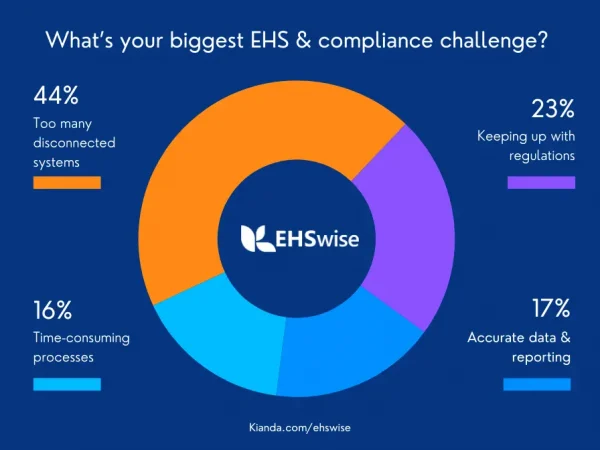When it comes to Environment, Health, and Safety management, organisations face a variety of challenges. A recent survey we ran with nearly 500 EHS professionals revealed a clear picture:
”The biggest challenge EHS professionals face is managing too many disconnected systems – a challenge cited by 44% of respondents.”
Other challenges include:
- Keeping up with regulations (23%)
- Accurate data and reporting (17%)
- Time-consuming processes (16%)
While all these issues matter, the prevalence of disconnected systems highlights a critical pain point for businesses striving to streamline their health and safety management.
This issue creates a ripple effect across organisations, making compliance harder, increasing risks, and leading to costly errors.
“But this is not just about technology; it’s about processes, leadership, and communication.”

The Hidden Risks of Disconnected EHS Systems
Disconnected systems create compliance gaps, inefficiencies, and blind spots that put organisations at risk. Many rely on spreadsheets, paper records, and isolated software, leading to:
1. Data silos & compliance gaps: Scattered safety data makes it hard to track incidents, ensure accurate reporting, and meet compliance deadlines. Inconsistent formats and delayed updates increase the risk of fines, failed audits, and legal issues.
2. Manual Processes that waste your time: Paper forms and spreadsheets slow down incident reporting, inspections, and compliance tracking. Teams spend more time managing data than improving safety—reducing their ability to act proactively.
3. No Real-Time Safety Visibility: If you are using different safety systems that don’t talk to each other you will struggle to identify trends, assess risks, and measure safety performance – resulting in reactive, rather than proactive, safety management.
Understanding the Complexity of Health and Safety Management Challenges
Health and safety management is an essential function in any organisation, ensuring that workplaces remain safe, environmentally responsible, and legally compliant. However, the complexity of regulations and the diverse nature of business operations mean that professionals face numerous challenges daily.
While disconnected systems lead the list, professionals also highlighted key challenges such as:
1. Leadership Buy-in & Organizational Support:
A successful health and safety management strategy requires full commitment from leadership. Without executive support, safety initiatives often struggle to gain traction. Many organisations still treat compliance as a reactive function rather than a proactive strategic goal.
Leadership buy-in can drive the necessary cultural shift, ensuring that safety and compliance are prioritized rather than viewed as a cost centre.
2. Behavior Management & Employee Engagement: Safety protocols are only as effective as their implementation. Even with well-defined policies, ensuring compliance at the employee level is a significant challenge.
Organisations often face resistance to change, especially when new procedures require additional effort or disrupt established workflows. Strong engagement strategies, ongoing training, and clear communication are critical to embedding a safety-conscious culture.
3. Competing Priorities & Resource Constraints:
Health and safety management professionals frequently juggle multiple priorities, from maintaining compliance and managing risks to optimizing operational efficiency.
Budget constraints often mean that safety initiatives take a backseat to other business goals. Without proper investment in people, processes, and technology, companies expose themselves to greater compliance risks and potential legal ramifications.
4. Lack of Support & Communication Across Teams: Health and safety management functions do not operate in isolation; they require seamless collaboration across departments such as HR, Operations, and IT. Poor communication can lead to misinformation, missed compliance deadlines, and disjointed safety initiatives.
Establishing clear communication channels and integrating health and safety management into overall business strategy can help mitigate these issues.
The Cost of Disconnected Health and Safety Management Systems
A fragmented approach to health and safety management doesn’t just create inefficiencies—it significantly increases risks. Organisations that rely on outdated or siloed systems often encounter.
Data inconsistencies that lead to reporting errors and non-compliance.
Redundant manual processes that waste time and resources.
Limited visibility into real-time compliance metrics, increasing the likelihood of safety incidents.
Increased risk exposure due to the inability to track and address hazards effectively.
When systems do not communicate, organisations struggle to obtain a holistic view of their compliance posture. This can lead to missed regulatory deadlines, penalties, and, in severe cases, legal action.
Workplace Safety & Compliance by the Numbers
Understanding the impact of poor health and safety management is crucial. Consider the following statistics:
In 2023, there were 5,283 fatal work injuries in the U.S., equating to a rate of 3.5 fatalities per 100,000 full-time equivalent workers. (OSHA)
33.7 million working days were lost due to injuries and ill health in 2023/24 in the UK, with 29.6 million attributed to ill health and 4.1 million due to injuries. (WorkNest)
Work-related deaths and injuries cost businesses and individuals $171 billion in 2019. (OSHA)
The Future of Health and Safety Management: Smart, Connected, and Automated
With a Software like EHSwise you can transition from disconnected legacy systems to a centralised, digital-first approach to health and safety management and compliance. With EHSwise you can:
- Consolidate all your disconnected systems into a single, streamlined platform for seamless EHS management.
- Automate compliance tracking and reporting, reducing the administrative burden on teams.
- Unify data across multiple departments, ensuring real-time visibility and better decision-making.
- Improve employee engagement through digital training modules and interactive dashboards.
- Enhance risk management with proactive monitoring and predictive analytics.
By leveraging technology, organisations can eliminate inefficiencies, improve safety outcomes, and ensure seamless regulatory compliance—without being bogged down by outdated systems and manual processes.
What’s Next? Taking Action for a Safer Future
If there’s one takeaway from this discussion, it’s that health and safety management needs a proactive, strategic, and technology-driven approach. The traditional, fragmented way of managing compliance is no longer sustainable in today’s fast-evolving regulatory landscape.
Organisations must start by identifying their key pain points and investing in solutions that simplify compliance, reduce risk, and enhance safety culture. The future of health and safety management is about integration, automation, and smarter decision-making.


